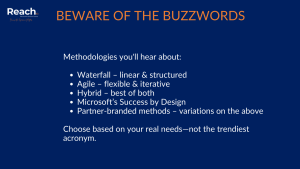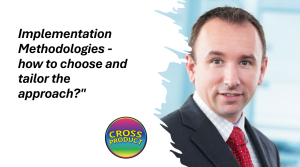This is the first in a series of blog posts exploring key insights on methodologies for Dynamics 365 implementation.
The Hidden Factor in Dynamics 365 Project Success
The failure rate for ERP implementations ranges between a staggering 65-80%. With such high stakes, what separates successful Dynamics 365 deployments from costly setbacks?
The answer often lies not in the technology itself, but in how you approach implementation.
Why Methodology Matters
Implementing Dynamics 365 isn’t merely a technical upgrade—it’s a business transformation initiative with far-reaching impact across your organization. Your implementation methodology shapes everything from timeline and budget adherence to user adoption and ultimately, ROI realization.
Nobody wants to watch a project derail due to poor planning or execution. Organizations typically embark on new ERP or CRM implementations during critical growth phases, preparing for acquisition, or when significant organizational change is on the horizon. These high-visibility initiatives can make or break careers and fiscal years.

Beyond the Methodology Buzzwords
When planning your Dynamics 365 implementation, you’ll likely encounter terms like:
- Waterfall: Sequential phases completed in order
- Agile: Iterative development with frequent deliverables
- Hybrid: Combining elements of both approaches
- Microsoft’s Success by Design: Microsoft’s structured framework for enterprise implementations
Also, many partners also have their own branded methodologies (Edge, QuickStart, Express, Rapid) which are typically variations of these core approaches.
There’s no universal blueprint—but there are patterns. The key is selecting an approach that reflects your organization’s culture, decision-making processes, and specific project requirements.
Common Implementation Pitfalls
There are several implementation traps to avoid:
- Applying a rigid methodology regardless of your organizational context
- Overlooking user training and adoption strategies until late in the project
- Underestimating the time needed for cross-functional alignment
- Treating all implementations with the same level of governance, regardless of complexity
- Waiting for issues to emerge rather than establishing proactive checkpoints
Matching Methodology to Project Complexity
One of the core recommendations is tailoring your approach to your project’s specific characteristics. Microsoft has historically categorized implementations into three types:
- Rapid: Smaller organizations, limited users, minimal customization
- Standard: Medium complexity, some customization, moderate integrations
- Enterprise: Large organizations, significant customization, complex integrations
As Nash Simeunovic, our Managing Principal, likes to colorfully explain: “Choosing the right type of project is like dating. You gotta take it slow if it’s your first rodeo but then go all in when you’re ready for the commitment.”

The documentation and governance requirements should scale accordingly. A 10-user implementation with no integrations requires a much lighter approach than a multinational deployment for 350 users in a regulated industry.
The Hybrid Approach: Best of Both Worlds
For most Dynamics 365 implementations, we would recommend a hybrid methodology that combines sequential and iterative elements:
- Sequential initial phases: Project discovery, mobilization, and solution modeling
- Iterative build phase: Developing and testing functionality in manageable sprints
- Sequential closing phases: Final preparation and deployment
This approach provides structure while maintaining flexibility to adapt as requirements evolve. Microsoft’s own guidance supports this balanced perspective.
Next Steps: Assessing Your Readiness
If you’re planning a Dynamics 365 implementation or already in progress, consider these questions:
- Does your chosen methodology reflect how decisions actually get made in your organization?
- Have you matched your governance approach to your project’s true complexity?
- Are you starting with standard functionality before considering customization?
- Have you established clear roles, responsibilities, and communication cadence?
In our next post, we’ll explore Microsoft’s Success by Design framework and how it can enhance your implementation approach, regardless of project size.
In Part 2 in our series, we’ll dive deeper into Microsoft’s Success by Design framework and how to leverage it effectively.

